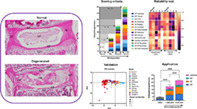- Record: found
- Abstract: found
- Article: found
Development of a standardized histopathology scoring system using machine learning algorithms for intervertebral disc degeneration in the mouse model—An ORS spine section initiative

Read this article at
Abstract
Mice have been increasingly used as preclinical model to elucidate mechanisms and test therapeutics for treating intervertebral disc degeneration (IDD). Several intervertebral disc (IVD) histological scoring systems have been proposed, but none exists that reliably quantitate mouse disc pathologies. Here, we report a new robust quantitative mouse IVD histopathological scoring system developed by building consensus from the spine community analyses of previous scoring systems and features noted on different mouse models of IDD. The new scoring system analyzes 14 key histopathological features from nucleus pulposus (NP), annulus fibrosus (AF), endplate (EP), and AF/NP/EP interface regions. Each feature is categorized and scored; hence, the weight for quantifying the disc histopathology is equally distributed and not driven by only a few features. We tested the new histopathological scoring criteria using images of lumbar and coccygeal discs from different IDD models of both sexes, including genetic, needle‐punctured, static compressive models, and natural aging mice spanning neonatal to old age stages. Moreover, disc sections from common histological preparation techniques and stains including H&E, SafraninO/Fast green, and FAST were analyzed to enable better cross‐study comparisons. Fleiss's multi‐rater agreement test shows significant agreement by both experienced and novice multiple raters for all 14 features on several mouse models and sections prepared using various histological techniques. The sensitivity and specificity of the new scoring system was validated using artificial intelligence and supervised and unsupervised machine learning algorithms, including artificial neural networks, k‐means clustering, and principal component analysis. Finally, we applied the new scoring system on established disc degeneration models and demonstrated high sensitivity and specificity of histopathological scoring changes. Overall, the new histopathological scoring system offers the ability to quantify histological changes in mouse models of disc degeneration and regeneration with high sensitivity and specificity.
Abstract
We have developed a new Mouse intErveRtebral disC histopathologY (MERCY) system using a step‐wise approach that included building consensus in the spine community, testing reliability using various mouse disc degeneration models for agreement by multiple raters, validating for high sensitivity and specificity using AI and machine learning algorithms, and applied on established models of murine disc degeneration. Hence, this new system can be broadly applied to quantify mouse IVD histopathology in disc degeneration and regeneration models.
Related collections
Most cited references53
- Record: found
- Abstract: found
- Article: not found
The measurement of observer agreement for categorical data.
- Record: found
- Abstract: found
- Article: not found
What low back pain is and why we need to pay attention
- Record: found
- Abstract: found
- Article: not found
